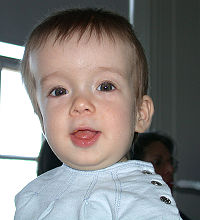
Photo from wikipedia
Study Design Prospective case series. Purpose To assess the corporal morphology of the fused body and adjacent segment conditions. Overview of Literature It is known that two fused vertebral bodies… Click to show full abstract
Study Design Prospective case series. Purpose To assess the corporal morphology of the fused body and adjacent segment conditions. Overview of Literature It is known that two fused vertebral bodies take the similar shape of the single body with inwaisting, with or without caudal flaring of the fused body, and that the fused body can cause the fusion disease at the adjacent segment that can be a risk factor for potential neurological compromise. Methods Radiograms of the 11 study subjects (six men and five women), aged 22–90 years who visited the outpatients’ clinic for various neck complaints without trauma history were examined. C4–5 synostosis was an incidental finding in all the subjects. Results All the fused bodies were inwaisted and had anterior caudal breaking but no interior corporal flaring. Adjacent segment disease was not found in eight patients aged <40 years. Disk degeneration was found at C3–4 and C5–6 in three patients each and at C6–7 in two patients. Disk degeneration was limited to the adjacent segments. Conclusions Degenerative disk changes are associated with the natural aging process, and the corporal morphology of the fused vertebral becomes inwaisted similar to that in the single vertebrae.
Journal Title: Asian Spine Journal
Year Published: 2021
Link to full text (if available)
Share on Social Media: Sign Up to like & get
recommendations!